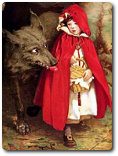The Handmaid's Tale Contents
Myth and fairy tale in The Handmaid's Tale
Atwood's interests in Gothic, in fairy tales and myth are part of her compelling interest in narrative. In The Handmaid's Tale, as in her later dystopian novels Oryx and Crake and The Year of the Flood, the narrators seem to feel that they must tell their stories even though they do not know whom their audience might be. As Offred says, in chapter 41:
 At various moments in The Handmaid's Tale this reflection of narrative tradition becomes more apparent. For example, Offred in her red robes recalls the Little Red Riding-Hood story:
At various moments in The Handmaid's Tale this reflection of narrative tradition becomes more apparent. For example, Offred in her red robes recalls the Little Red Riding-Hood story:
- In chapter 2, for example, Offred sees herself as ‘some fairytale figure in a red cloak, descending towards a moment of carelessness that is the same as danger.'
- In chapter 17 she imagines herself as a figure, ‘In the wood at midnight,' seeking, ‘a magic flower'.
Many myths and fairy tales, and especially stories influenced by the Gothic tradition, also draw on the idea of the dopplegänger or double, and there are many instances of this in The Handmaid's Tale. See Themes and significant ideas > Doubling for a discussion of this.
Recently Viewed
Scan and go

Scan on your mobile for direct link.